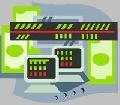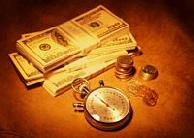
 |
|
| Financial Terms | |
| Hoarding |
|
Information about financial, finance, business, accounting, payroll, inventory, investment, money, inventory control, stock trading, financial advisor, tax advisor, credit.
Main Page: business, stock trading, tax advisor, finance, financial advisor, money, inventory, credit, |
Definition of Hoarding
HoardingSee labor hoarding.
Related Terms:Labor HoardingNot laying off redundant workers during a recession to ensure that skilled and experienced workers are available after the recession. direct laborthe time spent by individuals who work specifically labor efficiency variancethe number of hours actually worked minus the standard hours allowed for the production labor mix variance(actual mix X actual hours X standard rate) - (standard mix X actual hours X standard rate); labor rate variancethe actual rate (or actual weighted average rate) paid to labor for the period minus the standard rate multiplied by all hours actually worked during the period; labor yield variance(standard mix X actual hours X standard rate) - (standard mix X standard hours X standard rate); Direct laborlabor that is specifically incurred to create a product.  Indirect laborThe cost of any labor that supports the production process, but which is Labor efficiency varianceThe difference between the amount of time that was budgeted Labor rate varianceThe difference between the actual and standard direct labor rates Labor ForceThose people employed plus those actively seeking work. Fair Labor Standards Act of 1938A federal Act creating standards of overtime Common marketAn agreement between two or more countries that permits the free movement of capital Consumer Price Index (CPI)The CPI, as it is called, measures the prices of consumer goods and services and is a Economic unionAn agreement between two or more countries that allows the free movement of capital, Unemployment rateThe ratio of the number of people classified as unemployed to the total labor force.  Cost of goods soldThe cost of merchandise that a company sold this year. For manufacturing companies, the cost of raw VARIABLE EXPENSESThose that vary with the amount of goods you produce or sell. These may include utility bills, labor, etc. conversion costRefers to the sum of manufacturing direct labor and overhead overhead costsOverhead generally refers to indirect, in contrast to direct, product costThis is a key factor in the profit model of a business. Product absorption costinga cost accumulation and reporting actual cost systema valuation method that uses actual direct conversion costthe total of direct labor and overhead cost; European Union (EU)an economic alliance originally created global economyan economy characterized by the international joint costthe total of all costs (direct material, direct labor,  learning curvea model that helps predict how labor time mixany possible combination of material or labor inputs normal cost systema valuation method that uses actual overheadany factory or production cost that is indirect to prime costthe total cost of direct material and direct labor for a product standard cost carda document that summarizes the direct standard cost systema valuation method that uses predetermined variable costinga cost accumulation and reporting method Cost of goods soldThe accumulated total of all costs used to create a product or service, Direct costingA costing methodology that only assigns direct labor and material costs Factory overheadAll the costs incurred during the manufacturing process, minus the Manufacturing resource planning (MRP II)An expansion of the material requirements planning concept, with additional computer-based capabilities in the areas of Product costThe total of all costs assigned to a product, typically including direct Aggregate Production FunctionAn equation determining aggregate output as a function of aggregate inputs such as labor and capital. Aggregate Supply CurveCombinations of price level and income for which the labor market is in equilibrium. The short-run aggregate supply curve incorporates information and price/wage inflexibilities in the labor market, whereas the long-run aggregate supply curve does not. Discouraged WorkerAn unemployed person who gives up looking for work and so is no longer counted as in the labor force. Factor of ProductionA resource used to produce a good or service. The main macroeconomic factors of production are capital and labor. Institutionally Induced UnemploymentUnemployment due to institutional phenomena such as the degree of labor force unionization, the level of discrimination, and government policies such as unemployment insurance programs, minimum wages, or regulations on business. Participation RateFraction of the noninstitutionalized population 16 years of age and over that is in the labor force. ProductivityOutput per unit of input, usually measured as output per hour of labor. Structural UnemploymentUnemployment due to a mismatch between the skills or location of labor and the skills or location required by firms. Tax-Related Incomes Policy (TIP)Tax incentives for labor and business to induce them to conform to wage/price guidelines. Unemployment rateFraction of the labor force that is not employed. Cost of goods soldThe charge to expense of the direct materials, direct labor, and Related to : financial, finance, business, accounting, payroll, inventory, investment, money, inventory control, stock trading, financial advisor, tax advisor, credit. |